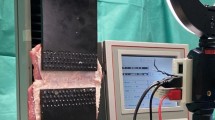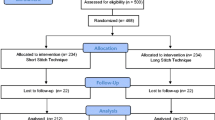Abstract
Background
Abdominal fascia plication using a simple continuous suture can sometimes cause tears in the fascia. This problem can be circumvented when the continuous horizontal mattress suture is used. No data exist from comparing the two suturing techniques. The aim of this study was to examine which technique can potentially cause greater tissue damage. The time required to perform each type of suture was also recorded.
Methods
Wound closure pads were plicated using the simple continuous and continuous horizontal mattress techniques performed by a single operator using Ethilon 2-0 nylon sutures. To verify their resilience, plastic bags were inflated beneath the pads to 30, 60, and 120 mmHg and tears were recorded. The time needed to perform the procedures was recorded using a stopwatch.
Results
Mean time for the continuous vertical mattress suture was 87 s and for the simple continuous suture 116 s. Tears in the pad that was plicated with the simple continuous pattern were significantly longer than those in the pad plicated with the continuous horizontal mattress pattern (fissure mean length ± SD = 3.958 ± 0.157 vs. 2.736 ± 0.157, respectively, p < 0.001). This finding was true for each of the three measured pressures (fissure mean length for 30 mmHg was 3.40 ± 1.807 vs. 2.12 ± 1.709 cm; for 60 mmHg, 3.94 ± 2.90 vs. 2.90 ± 1.893 cm; and for 120 mmHg, 4.54 ± 1.924 vs. 3.19 ± 2.110 cm; p < 0.001).
Conclusions
Continuous horizontal mattress pattern sutures were found to be superior to simple continuous pattern sutures in the suggested model, in terms of suturing time and damage to the pad. Further research in human subjects is still required.
Level of Evidence II
This journal requires that authors assign a level of evidence to each article. For a full description of these Evidence-Based Medicine ratings, please refer to the Table of Contents or the online Instructions to Authors www.springer.com/00266.



Similar content being viewed by others
References
The American Society for Aesthetic Plastic Surgery, Cosmetic Surgery National Data Bank Statistics, 2010. http://www.surgery.org/sites/default/files/Stats2010_1.pdf. Accessed August 2011
Nahas FX et al (1997) Should diastasis recti be corrected? Aesthetic Plast Surg 21(4):285–289
Momeni A et al (2008) The “rising sun technique” in abdominoplasty. Ann Plast Surg 60(4):343–348
Baroudi R, Moraes M (1991) Philosophy, technical principles, selection and indication in body contouring surgery. Aesthetic Plast Surg 15(1):1–18
Yousif NJ et al (2004) Transverse rectus sheath plication in abdominoplasty. Plast Reconstr Surg 114(3):778–784
Meeks GR et al (1995) Wound strength in abdominal incisions: a comparison of two continuous mass closure techniques in rats. Am J Obstet Gynecol 173(6):1676–1682 discussion 1682–1683
van’t Riet M, de Vos van Steenwijk PJ, Kleinrensink GJ, Steyerberg EW, Bonjer HJ (2002) Tensile strength of mesh fixation methods in laparoscopic incisional hernia repair. Surg Endosc 16(12):1713–1716
Austin BR, Henderson RA (2006) Buried tension sutures: force-tension comparisons of pulley, double butterfly, mattress, and simple interrupted suture patterns. Vet Surg 35(1):43–48
van Uchelen JH et al (2001) Complications from abdominoplasty in 86 patients. Plast Reconstr Surg 107(7):1869–1873
Neaman KC, Hansen JE (2007) Analysis of complications from abdominoplasty: a review of 206 cases at a university hospital. Ann Plast Surg 58(3):292–298
Höer J et al (2002) Tension banding closure of laparotomies: results of an experimental study in dogs. Langenbecks Arch Surg 387(7–8):309–314
Batchvarova Z et al (2008) Use of a submuscular resorbable mesh for correction of severe postpregnancy musculoaponeurotic laxity: an 11-year retrospective study. Plast Reconsstr Surg 121(4):1240–1248
Cengiz Y, Israelsson LA (2002) Closure of midline incisions. A lot of small, same-size stitches in the aponeurosis improve wound healing. Lakartidningen 99(24):2742–2744
Hollinsky C et al (2007) Preliminary results with the reinforced tension line: a new technique for patients with ventral abdominal wall hernias. Am J Surg 194(2):234–239
Nahas FX et al (2005) Long term follow up of correction of rectus diastasis. Plast Reconstr Surg 115(6):1736–1741 discussion 1742–1743
Millbourn D, Israelsson LA (2004) Wound complications and stitch length. Hernia 8(1):39–41
van Uchelen JH et al (2001) The long-term durability of plication of the anterior rectus sheath assessed by ultrasonography. Plast Reconstr Surg 107(6):1578–1584
Nahas FX et al (2001) Nylon versus polydioxanone in the correction of rectus diastasis. Plast Reconstr Surg 107(3):700–706
Axer H et al (2001) Collagen fibers in linea alba and rectus sheaths I. general scheme and morphological aspects. J Surg Res 96:127–134
Grässel D et al (2005) Anisotropy of human linea alba: a biomechanical study. J Surg Res 124(1):118–125
Conflict of interest
The authors have no conflicts of interest to disclose.
Author information
Authors and Affiliations
Corresponding author
Additional information
Oren Weissman and Niv Zmora contributed equally to this study.
Rights and permissions
About this article
Cite this article
Weissman, O., Zmora, N., Rozenblatt, S.M. et al. Simple Continuous Suture Versus Continuous Horizontal Mattress Suture for Plication of Abdominal Fascia: Which is Better?. Aesth Plast Surg 36, 1015–1018 (2012). https://doi.org/10.1007/s00266-012-9930-1
Received:
Accepted:
Published:
Issue Date:
DOI: https://doi.org/10.1007/s00266-012-9930-1




